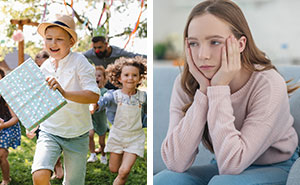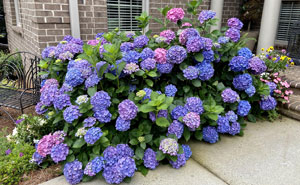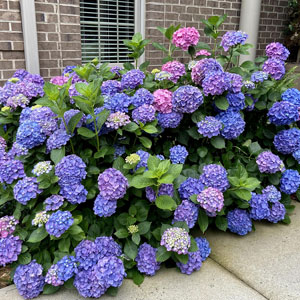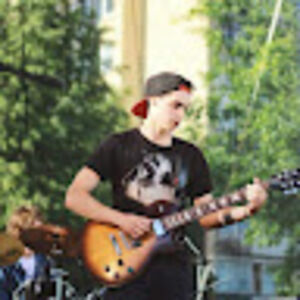Dancing has something primeval in it, don’t you think? Allowing your body to move freely following a rhythm frees you up and allows you to forget all your troubles, and that’s for certain! Also, dancing in a group of friends might give you a chance to laugh your lungs out straight from the hilarious moves made up on the spot. All in good spirits, of course! And, if the latter idea (having your friends over for a game dance) seems like a dandy one, why not check out these dancing games that we’ve rounded up in our latest list? There are loads to choose from, no matter your expectations!
Now, while most of these are, in fact, kids' games, nobody has ever said that they won’t work for adults, too. In fact, we think that the sillier the party games are, the more fun you are bound to get from them. Just try it if you don’t believe us! However, if you’re looking for a more sophisticated way to entertain yourself and the members of your fine soiree, there are also plenty of dance games for adults, too. So, from such classics as the Freeze dance game to a bit more elaborate examples, this list is brimming with excellent choices.
Okay, by now, you should be almost ready to pick a fun game and dance your heart out, correctomundo? Chances are, we got that right and can now suggest you scroll on down below and check out the cool dance games we’ve put on this list. Once you are done, be sure to give your favorite game a thumbs up and invite your friends over to do a test run of your choice!
This post may include affiliate links.
"Do All The Moves"
Create a circle. One dancer enters the center and does a maneuver. then returns to her original position. The subsequent dancer enters the middle and performs both the previous dancer's motion plus a brand-new move. The third dancer does the first two moves as well as one more. And so on until the final dancer is forced to perform each dance move while being in the center.
"Dance As I Say Not As I Dance"
Designate one dancer as the first leader. The leader will make a movement while speaking aloud as they do it. They can remark, "Run in place like me," as an illustration. The other dancers will mimic the leader's actions and speech. The leader has the power to change the situation by acting one way and speaking another. For instance, they could run while saying, "Jump with me!" The other dancers will in this instance imitate the leader's movements (jumping up and down), not what they are doing (running in place). If a dancer imitates the leader's movement rather than the one they are telling them to, they will be deemed "out."
"Copy Cat Dance Party!"
Play some upbeat music, then choose someone to mimic. They dance for about 20 seconds, pass the baton to someone fresh, and then everyone imitates them. The best course of action is to try to think of the dumbest dance moves you can so that your pals have to mimic you. Even the most bizarre dance moves appear fantastic when done by a large group of people. See if you can convince some random clubgoers to join in by trying it out. In this dance competition, there are no losers or winners.
"Freeze"
This entertaining game only requires music. Tell the children to dance along with the music and to stop when it does. The last child to move is ordered to leave as the children must freeze in place. Continue until there is only the winner left to perform.
"Ribbon Dancing"
This physically demanding game boosts creativity, calls for flexibility, and enhances hand-eye coordination. Each dancer will need their own stick with a ribbon attached. Each dancer should be given a stick, and you should teach them to dance to the music while waving their sticks and ribbons. Try several types of music; jazz and classical both work nicely. Older children could enjoy choreographing a dance to perform with the younger children in pairs or teams.
"Paint Dancing"
Painting and dance are two artistic forms that can be combined to make a special experience. You'll need a basic, washable floor mat, some bowls or plastic containers big enough for the dancers to put their feet in, and some washable paints for this dancing activity. Allow the children to stand on the mat alternately. Tell them to put their foot into a bowl and dance around while you play music. The youngsters will produce a vibrant, original painting while they do this.
"Passing Hats"
For this frantic dance game for teens, scour garage sales and charity shops for unusual and distinctive headwear. A hat becomes the thing that everyone wants to stay away from, kind of like playing hot potato. Start the music and put a hat on the head of a teenager. As the group dances, the hat is passed. The hat is harder to pass and receive when you're dancing. The teen wearing the hat is eliminated from the contest when the music stops. The winner is the teen who remains at the end.
"Act Out an Emotion"
Create some cards with a different feeling on each. Dancers take turns selecting a card and putting the feeling of the card into a performance. For instance, a dancer might show fear by backing away and extending their hands in front of them as though to fend off an adversary. Ask the audience to identify the feeling the dancer is trying to communicate.
"Book Balancing Ballet"
One light-weight book will be needed for each dancer, so gather some books. The objective is to move to music and practice some ballet routines while maintaining good posture and body control. Your dancers should strive to maintain their book on their heads while you play some music. If a dancer can catch their book if it falls, they won't be hurt. But if the book falls to the ground, they are out.
"Statues"
Partner up your dancers. The objective is to pose your partner's body like a dancer. When the position is just right, have the still dancer hold it while the other person in each pair studies the statues. The couples should then switch places and continue to sculpt. You have the option to assign postures or give instructions.
"Dance Switch"
Play some music, and have the kids impromptu dance. Call out several dance forms at random, such as disco, square dance, ballroom, hip-hop, or ballet, while standing next to the dance floor. Players are required to alter their dance motions to fit the specified dance style whenever it is announced.
"Zumba Dance"
Create a simple Zumba dancing fitness routine for visitors to enjoy while they work out and shake it all off. Simple Zumba routines to music include marching a short distance back and forth, hopping from side to side, or standing on one foot for a little period of time before switching. Spectators should be told to freeze immediately the music stops, and anyone still dancing should be removed.
"Musical Island Dance"
Prepare a number of paper or other mat "islands" with labels reading "Zombie Island," "Robot Island," "Disco Island," or any other dance-related theme you like before the party. Place the islands far apart and around a huge area. There are different ways to play this game, but no matter how you do it, players must leap onto an island to remain in the game. Here are two strategies for the game: As guests dance away from the islands, play music. The guests must reach an island when the music ends. The game ends for anyone who is not on an island. Play the game the other way around and instruct visitors to remain off the islands until the music starts. Then, the visitors must run to the nearest island and start dancing like robots, zombies, disco dancers, or whatever other island theme you have in mind. Any visitor who arrived late at an island is disqualified.
"High Five Dance"
It works wonders for breaking the ice and bringing kids together. In order to enjoy this game, have your kids form in pairs. Allow time for each pair to prepare. A scripted routine using hand gestures and body motions is performed by two dancers. High fives, claps, double high fives, low fives, and snaps will all have to be combined into a dance. Your child can have fun with it even if there is no music.
"Gunny Bag Dance"
Allow the kids to grip and enter the gunny sack. They are not allowed to tumble while dancing with the sack, according to the rule. Ask the children to dance inside the sack as you play music. Those that stumble will be eliminated. Play on until just one player is left at the conclusion.
"Rainbow Parachute Dance"
A rainbow parachute and enough room to dance are required. Make a circle with the children holding the parachute's elastic handle. As the music plays, instruct them to move and construct random formations. As the music plays, they are free to jump, sit, or move around while running.
"The Game of (Spatial) Relationships"
Create index cards with one space-related term on each card. This implies that both far and near would receive their own cards. Pair the cards in opposite directions, such that near and far are together. Give each dancer partner a deck of cards after dividing the group into pairs. For instance, one group would travel near and distant, and another would travel above and below. Let the dancers improvise as they investigate this link through movement. Ask the students to create 16 counts of choreography that examines this relationship after giving them time to improvise. Invite the audience to estimate what spatial relationship is being demonstrated, and have each group perform for the class.
"Beach Bag Movement Memory Quiz"
Inform the dancers that you will spend a class day "at the beach" and that you must pack a bag with everything you'll need for a great day in the sun. The bag will be filled by each dancer in turn, but you'll all need to keep track of what has been put in it as you go. To begin the game, designate a dancer who will pick an object to stuff in the bag and make a movement to symbolize it. For instance, individuals can add sunglasses by performing a movement that, either literally or figuratively, links to the concept of "sunglasses" for them. They will make the motion while uttering the phrase "sunglasses." The entire class will imitate the dancer's movement and pronounce the item's name. The following dancer will follow the first dancer's pattern and add their own movement. That sequence will be repeated after them by the entire class. The entire class will then repeat the sequence after the third dancer has added their own movement and repeated the first and second ones. This pattern will go on until each dancer has had a chance to add one item.
"The Limbo"
A pair of players hold the limbo stick about four feet off the ground to start the game. The next step requires participants to dance by going forward and bending backward to pass under the stick. Each time every visitor successfully completes a pass under the limbo stick at a specific height, the duo holding the limbo stick lowers it. A competitor is eliminated from the contest if they contact the stick during their turn. Being the lone player to pass under the limbo stick at its lowest position is the aim of this dance game.
"Dance Charades"
Dance charades is a twist on the classic game that tests your visitors' dance abilities and movie knowledge. The host sets up a container with folded-up pieces of paper before the party, each of which has the title of a well-known dance scene from a movie, such as "Dirty Dancing," "Saturday Night Fever," and "Flashdance." A person selects a piece of paper from the pile to begin the game, then she pantomimes the movie she chose to the other participants. A point is awarded to the first participant who correctly predicts the movie. At the conclusion of the game, the player with the most points wins.
"Balloon Dancing"
Two blown-up balloons will be required for each dancer. Play some music and tell the kids to juggle their balloons while dancing to the music. When you see dancers releasing their balloons, stop the music so they have time to depart the dance floor. This entertaining game is won by the dancer who stays on the dance floor the longest while juggling balloons.
"Beat Jumping"
Being ability to move in time with the music is essential for dancing. With the help of this upbeat game, teach kids how to do so effortlessly. Due to the game's intense physical demands, "Beat Jumping" also improves physical fitness. Play some music with a somewhat quick beat, and instruct your children to jump along with it. If you want, you can periodically surprise them by changing to music with a slower tempo.
"Switch It Up"
Play any of the following music types or others of your own choosing: waltz, hip-hop, jazz, disco, or samba. As you switch the music, tell your participants to alter their dance moves. For some of the musical genres you play, you might discover that they choose partners or create groups on their own.
"Choreography"
Imagination is exercised by coming up with a unique dance. Make a line out of your kids. Pick a kid to start the choreographed performance. Play some music, then ask the selected teen to demonstrate a dancing move. Allow the teenagers to do this alternately. The group does both the old dance move(s) and the new one whenever a new dance move is introduced. Stop when you think the kids can no longer recall any additional moves or when you feel everyone has had a turn.
"Handshakes"
Divide your dancers into pairs and give them instructions to come up with a handshake routine that involves at least five shakes. Your dancers will learn how effective nonverbal communication can be through this activity. Have each pair perform their handshake routine for the other dancers once your dancers have developed it.
"Snowball 'Fight'"
On a sheet of blank white paper, draw a dance step. Roll each piece of paper into a ball. The number you require will depend on how big your group is. Play some upbeat music while the dancers fling snowballs at one another. When the music stops, tell the dancers to grab the snowball that is nearest to them. Each dancer follows the instructions on the paper. Once you feel like every dancer has had a chance to try a few different dancing moves, turn on the music and repeat the activity.
"Meeting in the Middle"
Set up your dancers so that half of them are on one side of the space, and the other half are on the opposite side. In the middle, a dancer from each line meets by taking a travelling step. Either choose a step for the dancers to perform, or assign one. After touching hands, the dancers must rejoin the line. Continue until each dancer in the line has reached the center of the line.
"Memory Moves"
Kids should gather in a circle around the dance floor to play memory games. Determine which player will go first. That player will enter the circle's middle and devise a dancing move. The following player will enter the middle and perform the same dancing step. The second player then imitates the first player's dance motion before executing their own. The next player must do both dancing routines again and then add a third. Each dancer repeats the previous motion and then adds a new one as the game goes on. Anyone who can't replicate the series of dancing steps or forgets them is eliminated. Play continues until there is just one dancer left.
"Partner Switch"
Assign one player to hold a flag while standing in the center of the dance floor. Then, have the remaining dancers start dancing around the flag holder in pairs. The flag bearer will throw the flag into the air at random intervals. Everyone changes partners when the flag is raised. The flag holder must look for a partner as well. The new flag holder is whoever is left standing alone.
"Dance Corners"
With four different colors, indicate the four corners. A colorful flag can be hung to accomplish this, or you can tape a piece of colored paper to the floor in each corner. The four colors should be noted and put in a hat. Stop the music after the children have been dancing for a while, and instruct them to rush to a corner. Open the hat and take one of the colors out. That corner is no longer in play because those players are out.
"Dance Party Musical Chairs"
This variant of musical chairs is a fun way to include a dance party classic from your youth. Instead of placing the chairs in a straight line in the center of the space, arrange them so that they encircle (or roughly encircle) the dance floor. Children dance, and when the music stops, they move toward the seats, but they must dance there rather than move quickly. The player who is still standing after all the chairs have been occupied is eliminated, a chair is taken out, and the kids reappear on the dance floor for the subsequent round.
"Paintbrush Dance"
On a piece of paper, make a list of the various bodily parts to use as a gaming piece. You might list your hands, nose, elbows, knees, or head, for instance. The child will paint the floor and everything around her with the body part specified in the chit as the chit is called out. The next bodily part indicated in another chit is now the subject of the fictitious paintbrush. For instance, if the pretend paintbrush is on the elbow, your child will use the elbow to paint all around him.
"Jumping Jack Dance"
Children should jump as high as they can. Better if it's higher! Kids' bizarrest and finest jumps will be taken into consideration. You should award those children some stars.
"Animal Mask Dance"
Children's animal masks, a phone, or a TV may be needed for the game. Show your kids how animals move and behave on TV before starting the exercise. It aids in their comprehension of the dance's mechanics. Give yourself some time to practice. Play music after that and let the kids dance. Making a video of them dancing and showing it to them can make them feel a lot better.
"Find the Leader"
Make one person "it" and send them out of the room. Next, choose a leader to guide everyone in a silly dance. Tell them to be as silly as they can and to switch up their moves frequently. Start the song when "it" appears again. Everyone should strive to avoid looking at the leader while trying to follow his directions. Before the song is over, if "it" can identify the leader, the leader turns into "it," and you have to start over.
"Popcorn Dancing"
Turn up some music and get a beach ball or other lightweight ball. Someone must dance when the ball is thrown to them. To get their buddies to dance, they can then toss the ball to any of their friends.
"Body Part Party"
Before you play music, have your children form a circle. Set an example with this one by beginning by "dancing" one body part (like your arms or even just your right arm). The rest of the group should imitate your dancing. Pass the dance to the following person after a few counts, who must "dance" the same body part in a different manner. Choose a new body part to make dance after you've gone around the circle once.
"Shake A Leg With A Partner"
Just a piece of paper and a pencil will do. Make a few chits and label each one with the name of a pair. Pick a chit at random from a bowl of chits. Give the pair on the chit some time to mingle and practice a few dancing moves for the tune of choice before calling out their names. On the dance floor, let them clap their feet collectively. The winning couple will be the one who dances the most enjoyable.
"The Clapping Dance"
Bring every child to the dance floor and pair them off. Request that they devise dancing steps that call for them to clap or deliver a high-five. Give them time to plan and discuss the actions. To create rhythm, you can either play music or clap your hands together. The couple with the most inventive dance movements wins a prize.
"Blacklight Dance Party!"
I advise hosting a glow party with blacklights if you're uncomfortable dancing. Everything will become a little bit darker as a result, covering your faces. Put on bright neon-colored apparel or accent your face or body with neon paint. You'll soon be dancing the night away if you prepare some cocktails that glow in the dark.
"The Heartbeat Hop Dance Game"
For this one, you'll need two or more children. The caller will be one child (or adult), and the performer will be the other. To the beat of the song, the caller must say the word "one" or "two," and the performer then adjusts their movements. On the word "one," the performer must bounce around and make up imaginary floor patterns while the caller says the word "one." On the word "two": The performer must jump around on two feet and draw fictitious designs on the floor if the caller says the word "two."
"My Signature Move"
Inquire of each dancer what they enjoy most about dancing and/or other movement disciplines they have engaged in, such as yoga, soccer, or karate. What are their preferred motions or steps? Do they prefer to travel rapidly or slowly? firmly or delicately? Do they prefer swift or gentle movements? Simple or difficult movements? Do they prefer to develop specialized talents or express themselves freely? The dancers will utilize the answers to these questions to develop a "signature move" — a dance or movement expression that encapsulates everything they love about dance and movement — as soon as they have them. You may use examples from well-known artists and choreographers. They may use an entirely new move or a variation on one they've learned via dance training. Have the dancers trade off on each other's signature steps. A dancer should teach the other students their movement after demonstrating it for them so that they can "try on" each other's movement.
"Rainbow Suite"
Ask the students to come up with a dance move that begins with each letter of the word "RAINBOW" in their vocabulary. The learner will develop transition steps between each step after they have one for each letter of the word in order to connect the steps into a unified dance phrase.
"Dance Card Game"
The Dance Card Game involves making an arbitrary number of cards with different motions, shapes, or verbs (doing words like "run," "skip," etc.) written on them. These cards have a wide range of applications. A possible strategy is for each student to choose a card and then lead the class in that movement after taking a turn doing so. Another might be to shuffle the deck, take 4–8 cards out, lay them out in a line on the floor or stick them to the wall, and have the class imitate these actions as they complete their warm-up. The final idea may also be carried out in groups, or you could scatter the cards throughout the room and instruct the students to travel from one to the next in rhythm with the music. This is an excellent technique to warm up because it is entertaining, surprising, and adaptable to any class, regardless of ability level.
"Ball Dancing"
This easy game only requires a bell, a ball, music, and a dance floor. It's a fantastic method to get your kids interested in dancing games. Invite the kids to create a circle or a line. Give a youngster the ball, turn on the music, and instruct them to dance while passing the ball to another child when the bell rings. When passing the ball, a player exits the line or circle. This continues until the ball has been passed to each player.
"Elimination"
Observe your group and write down descriptive phrases on index cards, such as: wearing a blue shirt, wears glasses, has a pony tail, has on black pants. Place the index cards in a paper bag or basket. As you read a random card while pulling out a card at random, turn on some music and get your kids to dance. They are eliminated if the dancer's description matches the one on the card. The winner is the dancer who is left.
"Emoji Dancing"
Create (or buy) flash cards that each have an emoji on them as a starting point. For each one, pick a song that fits the atmosphere. Both songs and instrumental music are effective. The teenagers should be lined up and told to dance in accordance with the emoji's displayed emotion or mood.
"In the Spotlight"
For this entertaining game, a flashlight can be used if you don't have a real spotlight. Lower the lighting so that everyone can see the spotlight clearly. Play any music you like, and tell your teenagers to start dancing. Choose one teen to hold the flashlight and shine it on each dancer for ten to twenty seconds. The dancer in the spotlight gets eliminated from the contest when the music is stopped and the dancers all freeze. The dancer who is still on the floor when the game is over is the winner. You can allow your teenagers to dance in pairs if they so choose.
"Call and Response"
Hip hop dances frequently incorporate the "Call and Response" style. Assign your dancers to a circle of standing. To begin this exercise, pick a pupil and have them make a gesture or move. The individual after them in the circle answers. Up until all dancers have had a turn, this sequence will continue with each member of the circle making a distinct gesture or motion.
"Stretch with a Story"
Put your dancers in a straddle position while having them see themselves as a tall castle. They must move their fingers down their legs until they touch their feet, then bring them back up to simulate the king and queen crossing the drawbridge to enter the castle. Next, have them act as though the king and queen will fall off if they don't keep the drawbridge straight. Encourage them to extend forward while maintaining their legs close together and their backs flat.
"Spot Dance"
Dancers will work in pairs during this game. Each pair may only dance in the assigned area. The most effective way to accomplish this is to tape big circles onto the floor, then have dancers start by standing on them. Play some music and have them all dance around the circles without leaving them. They have to tempo up their dance when the music does. The couple is eliminated from the game whenever a foot leaves their designated space. You can start with huge circles and gradually swap them out for smaller ones as the dancing proceeds to make this game more difficult.
"Create a Dance"
Forget the cha-cha slide and the macarena. Encourage kids to create dance steps. As they would for line dancing, have them form a line. Have each player advance and execute a move one at a time. Before the following dancer adds a move, all dancers will practice that move several times. Along with the previous moves, each new one will be practiced. The new dance will already have been created by the time all participants have added and practiced their moves.
"Remote Dance"
At the party, your kids are having a good time. Using a phony remote, you can control them. A flashcard with remote-control buttons or an actual remote control are other options. When you shout out a word, you turn the music down. A word flashcard is another option. Children move in accordance with the instructions that are yelled forth. For instance, if you shout "Rewind," kids must jog backward or go backward. Additionally, their dance moves are rapid if you shout "Forward."
"Say Ola to Hula"
A hula hoop might be required to experience this. Make the kids dance with the hula hoop to a wonderful Hawaiian music. The top hula performer may be awarded a prize or modest prizes like stars. The benefit of this activity is that your kids don't have to know how to hula hoop around their waists. It might also be on the arm. Additionally, kids can use it as a straightforward prop to perform creative dance moves.
"Dancing With Claves (Clah-Vays)"
Ask the kids to sid down on the ground. You should instruct them to hold one stick in each hand and the other stick next to them. You then instruct them to sing "Hammer the Floor One," "Hammer the Floor One," and "Hammer the Floor 1" while striking the floor three times with a single stick. Then, while chanting "Hammer the Floor 2, Hammer the Floor 2, and Hammer the Floor 2," let them hammer the floor with both of the sticks. Allow them to simultaneously pound the floor with one foot and two sticks in the third round. They use both sticks and both feet in the ensuing round. In addition to the foot and stick movements during round number five, they also begin to shake their heads. The song should also indicate how many parts are used in each cycle. So, while they are holding the claves, you can invite the children to come up with as many inventive dancing moves as they can.
"The Zoo-Guess-Who Dance Game"
Two or more kids are needed for this dance. It's wonderful for reviewing animal names and traits as well as for those who adore animals. The animal names are called out by one child (or the parent), while the other child imitates the animal. Here are some examples of animal movements: tiger: the youngster relaxes on the floor, placing both hands there while arching their back. Snake: slither around on the ground while lying down. Rabbit: squat on the ground with your hands at your sides. Next, while still in the stance, leap in that same location. Kangaroo: the youngster leaps up and down a several times while standing still. Encourage them to leap while attempting to touch their bottoms with their feet. Cheetah: stay still while you "run" as quickly as you can.
"Describe a Dance"
Pair up all of the students. Give each member of the partnership a dance move they are familiar with. Each dancer will take some time to consider how they would describe the movement to someone who is not familiar with dance at all (for students who are brand new to dance, you can utilize simple movements like skip, hop, or run). They are not permitted to define the step using any phrases from the language of dance, the names of previous steps, or established body positions like the arabesque or croise. They are limited to using simple movement terms that the "ordinary" person would understand. If you think it would be beneficial for the dancers, you can give them some time to write down their description. Ask each dancer to describe their step to their partner in turn, sticking to the bare minimum of movement details. The step or any of its components may not be shown. They cannot utilize any jargon or terms associated with dance. The second dancer will give it their best go after the first partner describes the allocated step. Again, without using dance jargon, the "doing dancer" can ask their partner for more explanation if they are unable to grasp it right away. It will then be the "doing dancer's" opportunity to explain their allocated step to their partner after they have successfully completed it.
"Get in Shape"
Ask the dancers to form a long line in the dance area while holding hands. To turn their line into a circle, offer to cooperate. They are unable to speak as they work together to form a circle; instead, they are limited to nonverbal communication. Take a picture once the dancers believe they have shaped their line into the proper shape. The dancers should be shown the image so they can see how close they came. Have them retry it if required to see if they can become better. Repeat using various shapes, such as a triangle, square, figure 8, heart, star, peace sign, or alphabet letters.
"1-2-3 Dance!"
Form a circle with the dancers. Ask them to close their eyes and tell them to hold them closed until you shout "1-2-3 Dance" at them. The dancers will do a movement that finishes up pointing or reaching in the direction of one particular individual when they hear "1-2-3-Dance." Make sure that after making the movement, they do not switch who they are pointing at or reaching for. For a count of eight, have the dancers keep the pointing or reaching shape they created at the end of the movement while gazing at the person they are reaching toward. Both dancers are eliminated if the same dancer is gesturing or reaching back at them. The dancer will once more close their eyes and wait for the next command of "1-2-3 Dance" if the caller is pointing or reaching toward a different individual. If there are just two dancers left, the game is over.
"Twinkling Lights"
Set up the dancers in a sizable circle. One dancer will "ignite the flame" by producing a movement that emanates from their distal ends while initially starting modest and focused in their core. They will "pass" the movement to the dancer to their right to "light" their candle once it reaches their fingertips and toes. The second dancer will "transfer" the first dancer's movement inspiration to the third dancer by allowing it to pass through their body and onto their light. The dancers will keep repeating this procedure until everyone has received the "light" and passed it on to someone else.
"Snowflake Waltz"
Permission should be given for the dancers to begin in any desired "Snowflake Shape." As they design their shape, they must take into account various levels, spatial planes, orientations, body parts, lines, facings, and angles. They will maintain their shape for 8 counts before "melting" out of it and dancing on the ground for another 8 counts. They will discover a new Snowflake Shape on the first of the subsequent phrase, and the dance will then repeat. As many times as you like, repeat this sequence of melting dances to the floor and snowflake shapes.
















